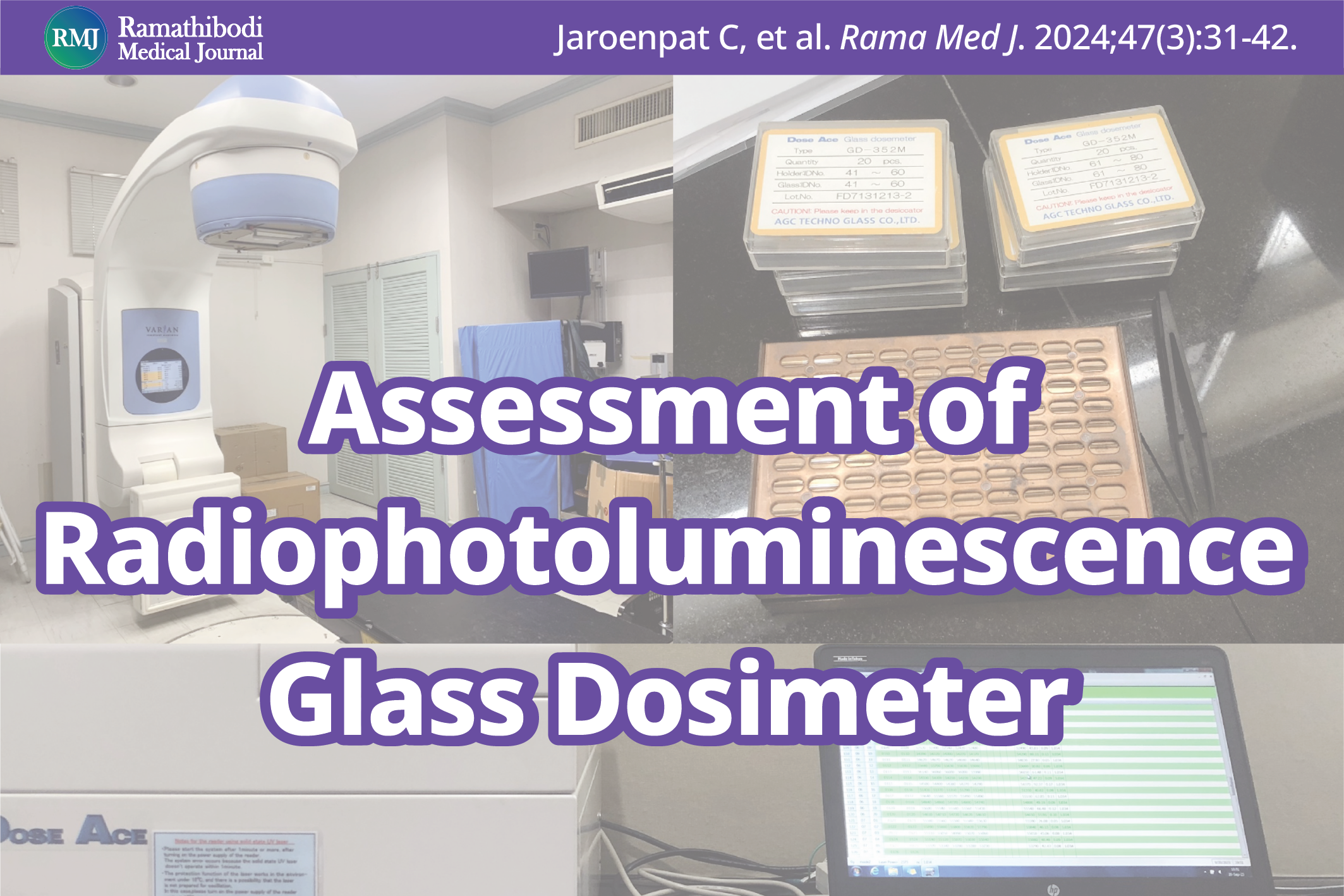Assessment of the Characteristics and the Uncertainty of Radiophotoluminescence Glass Dosimeter for Low Energy Photon
DOI:
https://doi.org/10.33165/rmj.2024.47.3.268527Keywords:
Radiophotoluminescence glass dosimeter, Dosimetric characteristics, Low energy photon beamsAbstract
Background: Medical dosimetry has become critical. Recognizing the efficiency of glass dosimeters, which exhibit good reproducibility, small fading effect, and linearity over a wide range, it has brought to this study that aims to assess the characteristics and the uncertainty of radiophotoluminescence glass dosimeter (RPLGD) for low energy photon in diagnostic radiology.
Objective: To assess the characteristics and estimate the uncertainty of RPLGD for low energy photon.
Methods: Following IAEA Technical Reports Series No. 457, the determination of the half-value layer of Varian Acuity simulator was followed by the calibration of a model GD-352M RPLGD. The dosimetric characteristics (uniformity, dose linearity, accuracy, energy response, reproducibility, reader reproducibility, and magazine positioning reproducibility) were determined. The minimum detectable dose and the uncertainty were then estimated.
Results: This study showed good uniformity within 0.09%, dose linearity with R2 = 1 around 0 - 10 mGy, the accuracy of measurement was 0.21% around 0.5 - 10 mGy, low energy response (70 - 120 kVp) within 0.05%, good reproducibility within 0.04%, magazine positioning reproducibility within 0.01%. The minimum detectable dose for a model GD-352M RPLGD was 0.01 mGy. The measurement of uncertainty was 3.83%.
Conclusions: RPLGD was accurate to measure low energy photon beams. Moreover, the understanding of characteristics of RPLGD helps measuring radiation dose appropriately according to the situation.
References
International Atomic Energy Agency. Dosimetry in Diagnostic Radiology: An International Code of Practice. Technical Reports Series No.457. International Atomic Energy Agency; 2007. Accessed April 17, 2024. https://www-pub.iaea.org/MTCD/Publications/PDF/TRS457_web.pdf
Dance DR, Christofides S, Maidment ADA, McLean ID, Ng KH, eds. Diagnostic Radiology Physics: A Handbook for Teachers and Students. International Atomic Energy Agency; 2014. Accessed April 17, 2024. https://www-pub.iaea.org/mtcd/publications/pdf/pub1564webnew-74666420.pdf
Huang DYC, Hsu SM. Radio-Photoluminescence Glass Dosimeter (RPLGD). In: Gali-Muhtasib H, ed. Advances in Cancer Therapy. IntechOpen; 2011:553-568. doi:10.5772/23710
Wannawikorn D, Potup P, Utitsarn K, Sookpeng S. The study of characteristic of optically stimulated luminescence NanoDot dosimeter for 6 megavoltage x-ray energy in radiotherapy. Journal of Thai Association of Radiation Oncology. 2020;26(2):14-29.
Bajaj NS, Palan CB, Chopra V, Dhoble SJ. An introduction to radio-photoluminescence and scintillation for dosimetric applications. In: Dhoble SJ, Chopra V, Nayar V, Kitis G, Poelman D, Swart HC, eds. Radiation Dosimetry Phosphors: Synthesis, Mechanisms, Properties and Analysis. Woodhead Publishing; 2022:431-454.
Manninen AL, Koivula A, Nieminen MT. The applicability of radiophotoluminescence dosemeter (RPLD) for measuring medical radiation (MR) doses. Radiat Prot Dosimetry. 2012;151(1):1-9. doi:10.1093/rpd/ncr463
Kim JS, Park BR, Yoo J, et al. Measurement uncertainty analysis of radiophotoluminescent glass dosimeter reader system based on GD-352M for estimation of protection quantity. Nucl Eng Technol. 2022;54(2):479-485. doi:10.1016/j.net.2021.08.016
Hsu SM, Yang HW, Yeh TC, et al. Synthesis and physical characteristics of radiophoto-luminescent glass dosimeters. Radiat Meas. 2007;42(4-5):621-624. doi:10.1016/j.radmeas.2007.01.053
Furetta C, Prokic M, Salamon R, Kitis G. Dosimetric characterisation of a new production of MgB4O7:Dy,Na thermoluminescent material. Appl Radiat Isot. 2000;52(2):243-250. doi:10.1016/s0969-8043(99)00124-4
Cohen M. Central axis depth dose data for use in radiotherapy. General introduction. Br J Radiol. 1972;11:8-17.
Wesolowska P, Cole A, Santos T, Bokulic T, Kazantsev P, Izewska J. Characterization of three solid state dosimetry systems for use in high energy photon dosimetry audits in radiotherapy. Radiat Meas. 2017;106:556-562. doi:10.1016/j.radmeas.2017.04.017

Downloads
Published
How to Cite
Issue
Section
License
Copyright (c) 2024 by the Authors. Licensee Ramathibodi Medical Journal.

This work is licensed under a Creative Commons Attribution-NonCommercial-NoDerivatives 4.0 International License.
















